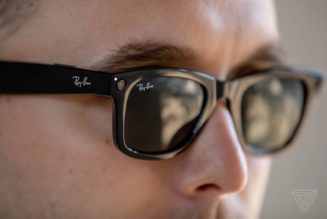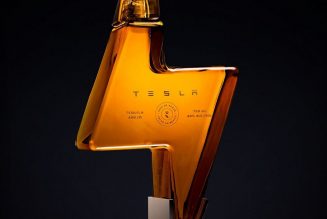Lightstorm Entertainment is a place where mind-boggling sights have become somewhat commonplace. James Cameron’s California-based company has produced nearly all of the director’s films since 1990, from Terminator 2 to The Abyss to Titanic and, most notably, 2009’s groundbreaking Avatar and its sequel Avatar: The Way of Water, which releases in theaters on December 16th.
In addition to offices, massive sound stages, and rooms filled with computers doing visual effects work, there’s a museum room featuring props like the Alien queen from Aliens, a Terminator from T2, 1:8-scale Titanic models and the actual Heart of the Ocean necklace. Walking through is mind-blowing stuff, but it’s just another Thursday at work for these artists.
But on this chilly November afternoon, employees walking around the studio lot are stopping dead in their tracks, jaws agape, and cellphone cameras at the ready. A real-life spaceship has touched down in Manhattan Beach, and it’s crabwalking around the parking lot.
:format(webp)/cdn.vox-cdn.com/uploads/chorus_asset/file/24286092/226444_Mercedes_Avatar_DGolson_0015.jpg)
a:hover]:text-gray-63 text-gray-63 dark:[&>a:hover]:text-gray-bd dark:text-gray-bd dark:[&>a]:text-gray-bd [&>a]:shadow-underline-gray-63 [&>a:hover]:shadow-underline-black dark:[&>a]:shadow-underline-gray dark:[&>a:hover]:shadow-underline-gray”>Photo by Daniel Golson for The Verge
This neon-lit chrome egg is the Mercedes-Benz Vision AVTR, a concept car first revealed at CES 2020 as a tie-in with the Avatar franchise that has been trotted out to a handful of auto shows and events since. With the sequel finally upon us nearly three years later, Mercedes got together with the film’s producers to showcase the car again, this time to a handful of journalists as part of promotion for the new movie.
A real-life spaceship has touched down in Manhattan Beach
Before interacting with the car, we sat down in the Lightstorm private screening room’s plush recliners to hop on a Zoom call with Gorden Wagener, who has been chief design officer of Mercedes-Benz, and Jon Landau, the Oscar-winning producer of Titanic and the Avatar movies. Sadly, we weren’t provided with any popcorn, but Landau and Wagener discussed how this strange partnership came to be and why it actually makes sense for both brands.
The project first started in 2018, about a year after the start of production on The Way of Water. Mercedes’ automotive designers worked with the production designers creating Pandora’s creatures, environments, sets, and effects, with both teams visiting each others’ studios in Germany and California. Mercedes saw thousands of designs from Weta FX, which is doing all of the visual effects work for the new movie, and Landau describes it as a very iterative process. Wagener and Landau joke about how a car’s design is frozen years before its release, but a movie isn’t done until the night of the premiere, so Mercedes got to witness many stages of the film’s production.
:format(webp)/cdn.vox-cdn.com/uploads/chorus_asset/file/24286090/226444_Mercedes_Avatar_DGolson_0013.jpg)
a:hover]:text-gray-63 text-gray-63 dark:[&>a:hover]:text-gray-bd dark:text-gray-bd dark:[&>a]:text-gray-bd [&>a]:shadow-underline-gray-63 [&>a:hover]:shadow-underline-black dark:[&>a]:shadow-underline-gray dark:[&>a:hover]:shadow-underline-gray”>Photo by Daniel Golson for The Verge
Why Avatar, though? The team was looking for partners to share in the franchise’s uncommon ethos that, in Landau’s words, “challenges us to look at our world a little bit differently, to understand that our actions have an impact on the people and world around us.” Both Landau and Wagener exclaim how the initial idea felt like a dream coming true, with Wagener saying that both brands share a common goal — and “a common responsibility, as a car maker,” he adds — of making the world a better place.
The Vision AVTR’s design was inspired by the nature of Pandora, the planet on which Avatar takes place, which Wagener says ties in perfectly with Mercedes-Benz’s design language. “Whatever we do is going to be beautiful,” says Wagener. He describes a form-follows-function approach in the way of architect Andrew Sullivan that’s more about “the awe of nature and the beauty of creation.”
On Pandora, the Na’vi ride incredible flying creatures called banshees, which provided an inspiration for the AVTR’s overall shape. The spherical wheels look bonkers, with the illuminated sections echoing the woodsprites from Pandora’s sacred tree. Thirty-three individually controlled flaps on the rear move organically as the AVTR drives, like gills or bristling wings.
The Vision AVTR’s design was inspired by the nature of Pandora, the planet on which Avatar takes place
Landau insisted on the AVTR having doors so the occupants are protected, and the way the huge glass panels open was taken from the motion of the banshee’s wings. Pandora is covered in bioluminescent fauna, so the AVTR’s cabin is full of radical lighting. There are a few elements present on the AVTR that made their way to Mercedes’ EQ production models, though, like its overall one-bow silhouette, slim head- and taillights and the large faux grille panel.
Maybe the funniest part of this collaboration is that the Vision AVTR won’t actually be in the new movie. All of the human machines we see on Pandora are brutalist, destructive military vehicles that destroy the planet’s ecosystem at the behest of human corporations, and as Wagener says, “we didn’t want it to be the bad guy.”
:format(webp)/cdn.vox-cdn.com/uploads/chorus_asset/file/24286086/226444_Mercedes_Avatar_DGolson_0009.jpg)
a:hover]:text-gray-63 text-gray-63 dark:[&>a:hover]:text-gray-bd dark:text-gray-bd dark:[&>a]:text-gray-bd [&>a]:shadow-underline-gray-63 [&>a:hover]:shadow-underline-black dark:[&>a]:shadow-underline-gray dark:[&>a:hover]:shadow-underline-gray”>Photo by Daniel Golson for The Verge
The Vision AVTR was thus designed to look like it would fit in with the world of Pandora instead of being a vision of what a car in the movie’s universe would actually be. (The Avatar and Mercedes folks stop ahead of confirming whether or not cars, and Mercedes itself, still exist at all in the 22nd century when the movie takes place.) But the AVTR exists here on our real Earth, and it’s my turn to drive it.
Maybe the funniest part of this collaboration is that the Vision AVTR won’t actually be in the new movie.
In Avatar, the Na’vi use their hair braids to make symbiotic brain connections with creatures on Pandora, and the Vision AVTR is turned on in a similar sort of way. Place your hand on the center console, and the AVTR literally pulses to life. The car’s spatial audio speakers play the thump of a heartbeat, eight exciters in the seats vibrate in sync, and ambient lighting fluctuates around the cabin.
A strange oval-shaped joystick rises up accordion-style from the center console and begins to pulse, too — that’s how the AVTR is actually controlled. There’s no steering wheel or pedals here, and the AVTR can be driven from either front seat. You push the joystick forward or back to accelerate or brake and tilt it to either side to turn or twist the top of the controller to crabwalk. The driving position is laid back, with cocoon-style seats and huge expanses of glass from the windshield and doors providing a great view out.
:format(webp)/cdn.vox-cdn.com/uploads/chorus_asset/file/24286089/226444_Mercedes_Avatar_DGolson_0012.jpg)
a:hover]:text-gray-63 text-gray-63 dark:[&>a:hover]:text-gray-bd dark:text-gray-bd dark:[&>a]:text-gray-bd [&>a]:shadow-underline-gray-63 [&>a:hover]:shadow-underline-black dark:[&>a]:shadow-underline-gray dark:[&>a:hover]:shadow-underline-gray”>Photo by Daniel Golson for The Verge
While most concept cars are usually remote-controlled and powered by tiny electric motors with single-digit top speeds, the Vision AVTR will do 35 mph. But that doesn’t mean it’s built like a normal car. The AVTR is obviously hand-built and very fragile.
On the move, it’s rickety and noisy and cold, with basically zero suspension or interior insulation, and a couple of the interior trim pieces are broken. The Mercedes employee conducting the drives has a custom iPhone app that can control the lights, interior functions, rear flaps and other bits from outside the car. Mercedes has said the AVTR has a 110kWh battery pack and four electric motors, with each wheel being able to be independently driven.
The AVTR is obviously hand-built and very fragile
After being driven around part of the lot, I get to take control. Even disregarding the fact that I’m sitting on the right side of the car, driving the AVTR is a strange experience. It employs the same joystick technology used for drivers with disabilities, and the control is sensitive and hard to modulate. If you press it forward and take your hand away, the AVTR will keep driving forward until the stick is reset at that same speed. Multiple times, I find myself accidentally crabwalking toward a parked car instead of turning normally, and it’s tough to make minor corrections.
:format(webp)/cdn.vox-cdn.com/uploads/chorus_asset/file/24286085/226444_Mercedes_Avatar_DGolson_0008.jpg)
a:hover]:text-gray-63 text-gray-63 dark:[&>a:hover]:text-gray-bd dark:text-gray-bd dark:[&>a]:text-gray-bd [&>a]:shadow-underline-gray-63 [&>a:hover]:shadow-underline-black dark:[&>a]:shadow-underline-gray dark:[&>a:hover]:shadow-underline-gray”>Photo by Daniel Golson for The Verge
The rear-wheel steering gives the AVTR a tight turning radius, while the crabwalking can be done at an angle of up to 30 degrees, so it doesn’t maneuver like a normal car, either. It feels ridiculous and eerie from inside the car but looks even more bizarre to the people around us.
I also don’t get to try out the AVTR’s infotainment system while driving, but I’m given a demo of how it works when the car is static. The entirety of the Y-shaped dashboard functions as a display through projection, and it shows the landscape on Pandora. Raise your hand, and menus are projected onto your palm, using gestures to make selections and control different functions. While parked, you can use the display to take a virtual tour of Pandora or one of three wonders of the natural world: the Huangshan Mountains in China, the Hyperion tree in the US, and Lake Hillier in Australia. It all works pretty well.
My time with the AVTR is short, and then it’s on to the next person, but I stick around so I can keep watching the UFO drive around as Mercedes continues giving rides around the lot to employees from Lightstorm and Disney. A security guard on a golf cart has served as a pace car for the Vision AVTR all day, making sure the path ahead is clear and no cars inadvertently cut off the multimillion-dollar concept car, so I hop on the back to really witness the AVTR in motion.
:format(webp)/cdn.vox-cdn.com/uploads/chorus_asset/file/24286083/226444_Mercedes_Avatar_DGolson_0006.jpg)
a:hover]:text-gray-63 text-gray-63 dark:[&>a:hover]:text-gray-bd dark:text-gray-bd dark:[&>a]:text-gray-bd [&>a]:shadow-underline-gray-63 [&>a:hover]:shadow-underline-black dark:[&>a]:shadow-underline-gray dark:[&>a:hover]:shadow-underline-gray”>Photo by Daniel Golson for The Verge
As the evening progresses and darkness falls, the AVTR reaches its maximum absurdity level. The ground is bathed in blue light from the wheels as the AVTR glides around, its actuated flaps making small automatic adjustments when the car starts moving sideways.
When touring Lightstorm’s museum, I’m told how James Cameron doesn’t make science fiction — he creates science fact. In all of his movies, everything from the creatures to the machines has to work, or it has to be engineered and designed so it would work in the fictional world of the movie. Before anything is done on a computer, the artists make real-life scale models that are then scanned and digitally created so Cameron can view and modify them in 3D.
1/5
a:hover]:text-gray-63 text-gray-63 dark:[&>a:hover]:text-gray-bd dark:text-gray-bd dark:[&>a]:text-gray-bd [&>a]:shadow-underline-gray-63 [&>a:hover]:shadow-underline-black dark:[&>a]:shadow-underline-gray dark:[&>a:hover]:shadow-underline-gray”>Photo by Daniel Golson for The Verge
This technique is even used in the Avatar franchise, which continues to be a pioneer in the realms of motion capture and CGI — for instance, a life-size silicone bust of Neytiri greets those who enter the room, and the massive mech featured in the first film’s climax was built for real and actually works.
The technology in the Vision AVTR isn’t as outlandish as it may seem, either. The production EQS has 10-degree rear steering, which, while not as dramatic as the AVTR’s, is still spectacular to witness and use, and crabwalking is a standard feature on the Hummer EV. The EQS also has AVTR-inspired features like wild ambient lighting, a full-width dashboard display and gesture controls. Even the most fantastical concept cars like this one can still preview design ideas and potential technologies that could be found on future production cars, all while letting the designers have some fun that’s free of pesky regulations.
Even the most fantastical concept cars like this one can still preview design ideas and potential technologies
Mercedes-Benz was the second-best-selling luxury car brand in the US last year, being barely edged out for the top spot by BMW. Meanwhile, Avatar: The Way of Water is a follow-up to what remains the highest-grossing movie of all time, with the original having made nearly $ 3 billion since 2009 — including more than $75 million from a recent, one-week-only IMAX rerelease.
There are huge expectations for the new movie — Cameron says it needs to make at least $2 billion just to break even — and just like with T2, Titanic, and the first Avatar, there have been sensational stories from Hollywood insiders ahead of the release talking about how much of a flop The Way of Water will be. The Vision AVTR is a headline-generating marketing tool, bringing an enormous number of eyes to both brands.
:format(webp)/cdn.vox-cdn.com/uploads/chorus_asset/file/24286087/226444_Mercedes_Avatar_DGolson_0010.jpg)
a:hover]:text-gray-63 text-gray-63 dark:[&>a:hover]:text-gray-bd dark:text-gray-bd dark:[&>a]:text-gray-bd [&>a]:shadow-underline-gray-63 [&>a:hover]:shadow-underline-black dark:[&>a]:shadow-underline-gray dark:[&>a:hover]:shadow-underline-gray”>Photo by Daniel Golson for The Verge
But it’s not about the money, really. Cynical as the sustainability and brand synergy messaging might seem, it’s a genuine effort for both parties. Cameron has been a climate change activist for decades, with Avatar serving as an allegory for the dangers facing our Earth. By 2039, Mercedes aims to have a carbon-neutral fleet and will exclusively sell electric cars by 2030 in most markets.
The Vision AVTR uses recycled materials made from old clothes and plastic bottles, vegan Dinamica microfiber and sustainably cultivated Karuun rattan wood. Mercedes’ production EQ cars are increasingly being made with many similar sustainable materials, with the EQS using 176 pounds of recycled and renewable materials in its manufacturing. “We share the belief that we need a more respectful approach to nature,” says Mercedes CEO Ola Källenius, calling Avatar a source of inspiration.
Landau says that when he saw the Vision AVTR at CES in 2020, he didn’t pay attention to it. Instead, like he does at movie premieres, he was watching the audience’s reaction, which he calls the true art form. The AVTR debuted to a crowd of 4,000 people, and Landau says that “there could be nothing more rewarding than the response we got.” Wagener agrees, calling the AVTR’s reveal one of the best shows that Mercedes has ever put on. “I think the Vision AVTR is one of the strongest statements we’ve ever made,” says Wagener, noting that he’s especially proud of bringing elements of it to production with the EQS.
The Vision AVTR will be present on the blue carpet for The Way of Water’s Hollywood premiere on December 12th, the audience response to which Landau will surely be intensely watching. To go along with the release of the movie, Mercedes is launching a new Avatar-themed ad campaign for its EQE SUV.
The short commercial shows a woman seemingly on Pandora, walking around a jungle and swimming in the ocean before coming out of her dream and driving off in the EQE, declaring that “Earth is our Pandora.” It’s silly, yes, but if it gets more people to consider the impact that the automotive industry has on our planet, it’s done its job.








